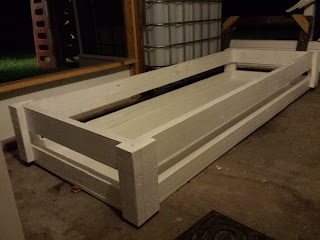It's been a long time coming. With other projects taking priority, the AP system took a back seat. Finally, the time has arrived to complete it.
First, installation of the duraskrim liner:
After trying to follow along with a video on YouTube that showed how one farmer installs his liner, mine (after folding the ends) came out like this:
It's not easy to see from the picture, but the folds actually proceed between the liner and the wall of the DWC tank, resulting in a smooth side wall. On the far side, I had to redo half the fold because the fold itself fell across where I had placed a hole for the water pump's bulkhead fitting. Not wanting to cut through multiple layers of liner, I double-folded that part of the liner and was able to move it sufficiently out of the way.
The final setup - minus many other pieces of plumbing and the nailer boards (which will go over the liner ends) - looks like this:
This actually came out exactly as designed (see one of my earlier posts), right down to the fact that the outlet on the fish tank is actually several inches too low! In the above picture, this situation had already been resolved by building a makeshift stand for the IBC container:
I ran some basic tests to check for leaks and to try out the double-head bell-siphon setup. Here are some notes on that:
- The standpipes are 2" diameter, and pass through 2" bulkhead fittings.
- Below, the far standpipe makes a 90 degree while the near pipe falls into a tee. Thus, both are joined to a common drain pipe.
- All the pipe below the standpipes is plumbed with 1 1/4" pipe and fittings.
- If the near pipe (the one with the tee) overflows first, the far pipe (the one with the elbow) won't siphon. It appears that the trapped air in the remainder of the drain pipe prevents the siphon from starting on that end.
- If the far pipe starts first, the near pipe will be drawn into the siphon action.
- Siphoning appears to be working reliably, but isn't pulling as fast as I was hoping it would. I think this may be caused by the 1 1/4" pipe. It should be noted that I believe this reduction in diameter is helping to start the siphon (thanks to the bottleneck effect), however, after the tee, I'm considering widening the pipe back to 2" to accommodate the combined flow of both siphons.
I did a quick timing test on the siphon. Right now I have no media in the grow bed and am only letting it fill to about 4.5 inches before the siphons kick in. At that depth, it is holding around 42 gallons. It took around 96 seconds to drain until siphon cut-off. That comes out to about 1600 gallons per hour of flow rate (0.44 gallons per second).
The fill pump is rated to a maximum flow rate of 1000 GPH. It has to make about a 6 foot rise, which should drop the rate (according to the chart on the box) to between 600 and 800 GPH. Expected fill rate for 4" of water is 127 seconds at 800 GPH, 170 seconds at 600 GPH.
I tested fill and drain with the pump running, and the grow bed successfully drained completely (the siphons cut off as expected). I have not yet timed what a filling drain rate is.
Here's the fish tank, with the top cut out. I tried to make it a hinged top, but the flexible container walls make it too flimsy and pointless to keep. Instead I'll put some sort of separate cover or mesh to keep the fish in and the children out. The return pipe (top) is not final yet. Neither is the grow bed feed pipe (bottom), which will run down into the bottom of the tank to help pull some of the waste material up.
Here's a picture of the temporary standpipe (elbow-side) with the bell removed. The other bell actually has a piece of Lexan super-glued to it, so that we could watch and ensure the siphon was actually working.
Aside from the nailer boards, the remaining work to be done on the system is as follows:
- The media guards need to be finished. In the picture immediately above, one of them (teal) can be seen in the foreground). I had drilled it with small holes at regular intervals along its surface, but I want to add more to ensure that it does not impede water flow out of the grow bed.
- The tank-to-grow-bed drain bulkhead fitting seal failed, and needs to be replaced. I had glued it in place with 3M 5200 Marine Sealant, but the sealant did not bond well between the PE tank sides and the fitting. Consequently, when the waterline in the tank went above the fitting, it started leaking. I ended up dropping the pump into the tank and transferring about 80 gallons into the grow bed and DWC tank to stop the leak and repair the fitting.
- The actual feeder pipes need to be cut and installed. These will go down into the grow bed and will be set up to ensure that fish water doesn't splash any of the plants.
- As mentioned above, an attempt will be made to improve drain rates a little more - it might be superfluous, but I think it's worth a shot, and will only require the purchase of a single fitting.
- The air lines need to be secured (they are now in place, but not pictured).
- The lighting needs to be built and installed.
After all that, we should be good to go!














